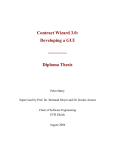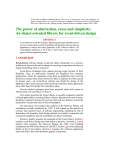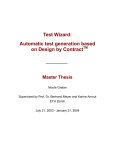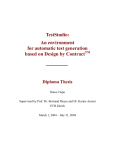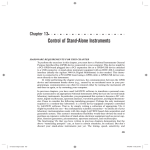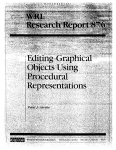Download Final report
Transcript
Precondition Enforcement Analysis for
Quality Assurance
Nadja Beeli
Submitted to the degree of
Master of Science ETH in Computer Science
Supervised by Prof. Dr. Bertrand Meyer and Dr. Karine Arnout
April - October 2004
Abstract
The crash of Ariane 5 dramatically showed the importance of correctness in software and that
the goal to produce reliable software has not yet been achieved. Therefore, this master thesis
targets the development of a static analysis, which ensures preconditions and thus enhances a
sound reuse of software.
As a result, we could determine many preconditions to be fulfilled, especially preconditions
of a certain class, which are used most often. This confirms that static analysis is justified in a
development process of quality software.
Acknowledgements
I would like to deeply thank Dr. Karine Arnout for her support and explanations on the
subject of the thesis, and her prompt answers. Furthermore I thank Prof. Dr. Bertrand Meyer,
who gave me the opportunity to accomplish my master thesis in the field of Design by
Contract, and for his introduction on the static analysis of preconditions.
A special thank goes to Éric Bezault, who introduced me to GOBO Eiffel, and swiftly
answered my questions.
2
Table of Contents
Chapter 1
- Concept of Contracts ........................................................................................6
1.1.
The Crash of Ariane 5.............................................................................................6
1.2.
Design by Contract in Context of Ariane 5..............................................................6
1.3.
Concept of Semantic Contracts ...............................................................................8
Chapter 2
- Contract Assurance .........................................................................................16
2.1.
Checking Methods ................................................................................................16
2.2.
Development Process with Precondition Enforcement Analysis ............................18
Chapter 3
- Static Contract Verification.............................................................................20
3.1.
Information Used for Verification .........................................................................21
3.2.
General Approach.................................................................................................21
3.2.1.
Comparison of Precondition ..........................................................................24
3.2.2.
Is the Precondition satisfied? .........................................................................27
3.3.
Specific Approach.................................................................................................28
Chapter 4
- Design and Implementation ............................................................................31
4.1.
Eiffel Analyzer .....................................................................................................31
4.2.
Precondition Enforcement Analysis ......................................................................35
4.3.
Graphical User Interface (GUI) .............................................................................38
4.4.
Extensions ............................................................................................................41
Chapter 5
5.1.
- Project Plan ....................................................................................................42
Achievements .......................................................................................................42
5.1.1.
Static Analysis ..............................................................................................42
5.1.2.
Graphical User Interface (GUI) .....................................................................42
5.2.
Limitations ...........................................................................................................42
Chapter 6
- Experimental Results ......................................................................................43
Chapter 7
- Conclusions ....................................................................................................44
Chapter 8
- User Manual ...................................................................................................45
3
Introduction
In Eiffel, Design by Contract [1] plays a central role in development of quality software.
Contracts are the fundamental ingredient for the semantic description of software interfaces,
explicitly regulating all the functionality, which a component offers to and consumes from the
environment. Thereby, all dependencies between software components, be it procedures,
functions, objects etc., must be solely defined by the interfaces. In this respect, interfaces both
enforce obligations and offer guarantees to the participating components. Whereas Eiffel
contracts hereby focus on the semantic specification, the syntactical contracts are manifested
in the signatures of routines (ordered parameters with types and a return type for functions) as
well as the features (attributes and routines) of classes.
The purpose of Design by Contract is the establishment of programming with clearly declared
dependencies. It is more than pure program documentation, enabling languageinstitutionalized specification that can be verified by both man and machine. This inherently
helps improving program quality and sets the basis for safe reuse of software components.
The concrete representation of Eiffel contracts is in terms of assertions, appearing in the role
of a routine preconditions, postconditions or class invariants. Contracts are usually checked at
runtime for testing and debugging reasons. When a contract rule is violated and not handled
by the exception mechanism, the program immediately aborts with an exception. For release
versions, the contract monitoring turned off, since the program is assumed to be correct. Even
after exhaustive dynamic testing, we can never be convinced that every possible case has been
tested and that the program is entirely correct.
A static analysis determines at compile time, whether the contracts hold in any case of an
execution scenario. Furthermore, performance for dynamic testing can be enhanced by
elimination of redundant runtime checks. However, a static analysis is conservative, i.e. the
analysis sometimes cannot determine that a condition is fulfilled, although the condition holds
de facto. Consequently, it occurs that contracts are undecidable to be fulfilled, although they
are always kept. While time can be saved for dynamic testing, it has to be spent on the static
analysis. However, the reward of a successful static analysis is unequally higher, because the
contract is then guaranteed to permanently hold. Therefore, a hybrid approach is justified,
which makes as great use of a static analysis as possible, and applies manual or dynamic
testing for the remaining undecidable cases.
In this thesis, we focus on a static analysis for preconditions since in reuse of libraries, it is
particularly important for a client to assure a routine’s proper use. Consequently, we aim to
determine for as many preconditions to be fulfilled as possible with a static analysis. This
could be achieved considering the fact that the vast majority of precondition clauses consist of
primitive expressions. This way a core problem of object-orientation could be addressed,
being the conceptually dangling references, i.e. void pointers. A supplying routine often
ensures in the precondition that an object reference must not be void. As a result, the
developed static analyzer is particularly successful in detecting redundant nil checks.
Our analyzer also supports more general precondition expressions, but the results are not as
rich for different reasons. On the one hand, there are not that many appropriately complex
preconditions and on the other hand, there are such complex expressions, which would
require an extensive analysis beyond the scope of this thesis.
4
As a further contribution, we provide a graphic tool showing in two separate enumerations,
the calls that could not be determined to be fulfilled as well as the fulfilled calls. With these
steps, one can ensure that software gets more and more reliable.
5
Chapter 1 - Concept of Contracts
1.1.
The Crash of Ariane 5
„On 4 June 1996, the maiden flight of Ariane 5 launcher ended in a failure. Only about 40
seconds after initiation of the flight sequence, at an altitude of about 3700m, the launcher
veered off its flight path, broke up and exploded.” (Report of the inquiry board [4])
The $500-million crash of the first Ariane 5 launcher, dramatically illustrated what unsafe
code reuse can cause. The stirring error happened in the Inertial Reference System (SRI),
which measures the attitude of the launcher and its movements in space. A conversion from a
64-bit-floating-point number (the missions “horizontal bias”) to a 16-bit signed integer
produced a runtime exception, because the number was not representable with 16 bits. The
exception was not handled and the uncaught exception was processed in the On-Board
computer like flight data, causing a failure and subsequently the crash of Ariane 5.
The SRI software actually worked well with Ariane 4, so the question was what caused the
catastrophe with Ariane 5. The reason is the higher horizontal velocity of Ariane 5, resulting
in an overflow. Furthermore, the alignment function of the SRI should already have been
turned off, because “this software module computes meaningful results only before lift-off.
As soon as the launcher lifts off, this function serves no purpose”. This functionality was used
in early versions of Ariane, to enable quick re-initialization in case of a hold in the countdown, but has fallen into oblivion.
1.2.
Design by Contract in Context of Ariane 5
With an extensive use of Design by Contract, such an error would have been prevented. First,
the conversion error would not have happened, if the precondition and the limit for the
horizontal bias’s bound would have been correctly set as outlined in Figure 1-1, where
Maximal_horizontal_bias is set, and the precondition for the conversion operation is
horizontal_bias <= Maximal_horizontal_bias. Second, the additional
feature, which was responsible, that the alignment function has not been turned off, would
have been properly documented as well and therefore not used for Ariane 5. This is also
sketched in Figure 1-1, where the limits of the horizontal velocity for the alignment function
are expressed with the precondition 0 <= actual_horizontal_velocity and
actual_horizontal_velocity < Maximal_horizontal_velocity.
The program has still to be checked with Ariane 5 requirements varying from Ariane 4, either
by dynamic or manual testing. It would be a great advantage to verify such preconditions by a
static analysis giving absolute guarantees.
6
…
feature -- Constants
Maximal_horizontal_bias: INTEGER is 32767
-- = 2^15 – 1
-- Limit of maximal horizontal bias
Maximal_horizontal_velocity: INTEGER is 4122
-- Limit of maximal horizontal velocity for
-- alignment function
feature -- Conversion
convert_horizontal_bias (horizontal_bias: DOUBLE): INTEGER is
-- Convert `horizontal_bias' to `INTEGER'.
require
bias_limited: horizontal_bias <= Maximal_horizontal_bias
do
Result := horizontal_bias.truncated_to_integer
ensure
…
end
feature -- Miscellaneous
postpone_turn_off (actual_horizontal_velocity: INTEGER) is
-- Postpone turning off the alignment function for
-- reinitialisation in case of a hold in the count-down.
-- `actual_horizontal_velocity' needs to be within the
-- required limit. Turn off this feature, if the limit
-- cannot be guaranteed.
require
positive_velocity: 0 <= actual_horizontal_velocity
maximal_horizontal_velocity:
actual_horizontal_velocity < Maximal_horizontal_velocity
do …
ensure
…
end
…
Figure 1-1: Conversion and alignment function, in Eiffel, using Design by Contract.
7
The programmer, who implemented the additional feature, was not recommended to use
Design by Contract and therefore he could only document it separately from the code, where
especially rarely used routines and their requirements can easily be forgotten.
Ken Garlington criticizes in [5] that contract writing needs too much time for no immediate
reward, since a program can be correct without use of contracts. At a first glance, this might
seem to be true but on the one hand, if a programmer is used to writing contracts and he is
conscious about the requirements his software has to meet, the time spent is negligible. Even
if a programmer is not trained in writing contracts, by declaratively expressing the
requirements of his software, he is more conscious about the requirements and the benefits of
his code and therefore can avoid many errors. On the other hand, if someone has to reuse the
code he profits, if every effect of the program is properly described, so that he immediately
understands the purpose of components he wants to reuse.
Of course, writing contracts is something everyone has to get used to. Especially at the
beginning, it takes some discipline to write contracts properly but it is worth for testing and
for everyone, who has to look at the code again.
More comments on the Ariane 5 crash and Design by Contract can be read in [5].
1.3.
Concept of Semantic Contracts
One of the fundamental pillars of structured programming is component-oriented design
paradigm. The complexity is hereby decomposed into small program units, called the
components. As the most essential point, components are solely accessible via interfaces,
which explicitly define all dependencies between the component and the environment. Each
interface constitutes a syntactic and a semantic part that are equally important for totally
expressing all the inter-component interrelations and dependencies. The purpose of
component-oriented philosophy is apparent:
•
According to the principle of divide and conquer, the complexity of a software system
is rigorously reduced by decomposition. The dependencies are entirely concentrated
within the interfaces acting as contracts that have to be fulfilled by both the providing
and the consuming components. The components can fully encapsulate
implementation details as black boxes.
•
Due to the explicitly formulated interfaces, a component behind becomes
exchangeable as long as it completely agrees with the interface. This is the sound
foundation for safe software maintenance and flexible extensions.
•
As components form abstractions with clearly specified functionality, safe software
reusability is enabled.
In the object-oriented programming paradigm, we can identify two kinds of components: (1) a
routine, covering functions and procedures, as well as (2) objects, described by classes.
Classically, the syntactic interface of a routine is specified by the signature, comprising the
parameter types (also called the formal arguments) and the return type (in case of functions),
their passing semantics and ordering. Analogously, an object’s syntactic interface consists of
the features an object offers, i.e. the applicable routines, provided attributes and generic type
parameters. The rules of a programming language ensure that no program participant can
8
circumvent these syntactic contracts. (An appropriate compiler is typically sufficient to
enforce these rules).
The other but not less essential part of an interface is the semantic contract. This is to
concretise both the meaning of the component and its syntactic elements as well as all the
terms for correctly using the components. Whereas a reasonable level of syntactic interface
description has probably been reached in programming, the possibilities for declaring the
semantics of an interface are clearly far from what is required for accurate contractual
specifications. This is especially true for most of the popular main-stream programming
languages, such as C++, Java, and C#, to only name a few. An extremely modest kind of
interface semantics may be the comments and good naming of components, features,
parameters, and attributes etc, provided they are adhered to the interface. What is particularly
regrettable is that none of these semantic conditions are enforced for the interaction and use of
the components. There is for instance, no help by the machinery that these perfectly weak
semantics of comments and naming are effectually agreeing with use-semantics on the client
side.
Although one may suggest that the precise semantic description is truly more difficult than for
syntax, there are numerous promising approaches for semantic contract specification, among
some are realized in Eiffel. However, a methodology for thorough semantic specification,
which is also verifiable by a computer in reasonable time, has not yet been found.
Nevertheless, a certain level of semantic accuracy in the contractual agreement between
components can be achieved. First, we quickly review some archetypical constructs for
semantic specifications that are both equally well understandable by man and computer.
Invariants
An invariant is a condition that permanently holds during the entire computation of a defined
program scope. Thereby, the computation process is abstracted as a series of state transitions,
called atomic actions. Both before and after the execution of an atomic action, the invariant is
fulfilled.
An action may appear in different granularity. In a standard imperative programming
language, it can be perceived as a statement, or a basis operation is the notion of operational
semantics. There may nonetheless be more complex atomic action, such as a general
statement block, an entire routine.
A further concept traditionally mentioned together with invariants is the variant.
Variants
A variant is only defined with respect to a repetitive execution process and specifies a
maximum number of remaining iterations until the termination of the repetition.
A classical execution repetition is a loop in imperative programming. At the beginning of
each iteration step, the variant defines a positive numeric value. The value of a variant has to
monotonously decrease with each iteration step and the repetition must eventually terminate
at latest when the value has reached zero.
The combination of invariants and variants already enable a surprisingly powerful set for
verifying interesting programs. The invariant hereby primarily focuses on the state
consistency for the intended purpose of the program, whereas the variant is for guaranteeing
the termination of a program. The example in Figure 1-2 illustrates a binary search, where
invariants and variants prove the correctness of the algorithm. From the invariant and loop
9
termination condition, it is immediately implied that the result is either in a.item(l) or it
is not contained in the array at all.
binary_search (a: ARRAY [INTEGER]; k: INTEGER): BOOOLEAN is
-- Does ‘k' exist in sorted ‘a' with ‘binary_search'?
-- Suppose the following sentinels
-- a.item (1) = -Infinity
-- a.item (a.count) = Infinity
local
l, r, m: INTEGER
do
from
l := 1; r := a.count
invariant
(a.item (l) <= k)) and (k < a.item (r))
variant
r – l
until r /= l + 1 loop
m := (l + r) // 2
if a.item (m) <= k then
l:= m
else
r := m
end
end
-- (r = l + 1) and invariant implies (a.item (l) <= k < a.item (l+1))
Result := a.item (l) = k
end
Figure 1-2: Binary Search with a Loop
Further archetypes for semantic contracts are conditions that do not necessarily hold all the
time but are exactly fulfilled at certain defined program places. This may be used for setting
program actions in a semantic context, such as with the so called Hoare triples.
Hoare Logic
A Hoare correctness formula {P} A {R} defines a program action A and two conditions P and
R, such that R is fulfilled after each execution of A, provided that P holds at the beginning of
the execution. P is called the precondition and R the postcondition of A.
What is in primary interest of this analysis, is that the pre- and postconditions are exactly
denoting a semantic contract part of an interface for a component, here being the program
action. The precondition secures the terms of contract for the sound use of the functionality,
whereas the postconditions concretises the effective result that is offered by the component.
Of course, the conditions must not reveal any implementation details of the component.
The Hoare logic inherently manifests the notion of mathematical induction proof, where the
precondition represents an induction hypothesis, under which fulfilment the postcondition can
10
be implied. Especially for recursive problems but not limited to those, the induction is the
very natural and effective mechanism for correctness proofs (c.f. Figure 1-3).
recursive_binary_search (a: ARRAY [INTEGER]; k: INTEGER;
l: INTEGER; r: INTEGER): BOOLEAN is
-- Does ‘k' exist in sorted ‘a' with ‘binary_search'?
require
is_between_limits:
(l < r) and (a.item (l) <= k) and (k < a.item (r))
local
m: INTEGER
do
if l = r + 1 then
-- a.item (l) <= k < a.item (r)
Result := a.item (l) = k
else
m := (l + r) // 2
if a.item (m) <= k then
l := m
else
r := m
end
Result := recursive_binary_search (a, k, l, r)
end
end
Figure 1-3: Binary Search on an array programmed as a recursive function
Invariants, variants as well as the pre- and postconditions can be verified and ensured with
several techniques, which we discuss in the subsequent chapter.
A core question in the specification of semantic condition is in what terms they are expressed.
There are roughly two categories of approaches.
•
Special descriptive languages: Semantic conditions are described in a special
descriptive language. This enables the high-level declaration of conditions, with mere
focus on the semantics in total liberation from the imperative computation of this
condition. It can be namely observed that the necessary semantic contracts are actually
required due to the lacking expressiveness of standard programming language for
expressing such constructs by means of the classical semantic elements. A good
candidate for such descriptive languages would be for example, the support of
quantifiers. On the other hand, there are not many declarative programming languages,
which are also reasonably efficient in verification. (An example of a rather efficient
descriptive language is SQL, whereas Prolog entails exponential time complexity). A
further benefit of special languages is that more sophisticated semantic conditions may
be supported, such as limits on execution time, memory or power consumption etc.
•
Conventional imperative language: It is straightforward to formulate semantic
conditions in uniformity of the standard imperative programming language. However,
11
more complex conditions are not definable as pure Boolean formulas, which do not
involve execution of other program parts. Therefore, functions have to be enforcedly
used in the semantic condition, to enable sufficient flexibility. In this case, it must be
however excluded that the execution of such functions causes side effects on the
system. We will now discuss this issue in detail.
To simplify the use of contracts, Eiffel features preconditions, postconditions and class
invariants as institutionalized concepts of the programming language. Beside the interfacerelated contracts, loop invariants and variants are provided. For pragmatic reasons and
convenient usability, Eiffel chooses the approach of self-expressed semantic Boolean
formulas. In the following, we review the concrete kinds of Eiffel semantic conditions.
Preconditions
With a precondition, a routine can specify a semantic condition, which must be fulfilled for
all invocations of the corresponding routine. A precondition hence obliges the clients to keep
its part of the postulated contract, such that the routine can fully rely on this fact. The
expression belongs to the interface of a routine and has an equal importance as the routine’s
signature.
bank_withdraw (account: ACCOUNT; amount: INTEGER) is
-- Withdraw ‘amount’ from ‘account’.
require
enough_mony: account.balance >= amount
…
end
Figure 1-4: Precondition in Eiffel
Postconditions
The postcondition describes a functionality, which must eventually hold at the execution end
of a routine. A postcondition can be viewed as a contract element of the routine, guaranteeing
certain semantic properties for its clients. In this way, it acts as the opposite concept of a
precondition, where the contract imposes an obligation for calling the routine itself. In
combination with preconditions, inductive reasoning about function compositions is enabled
in a program. On the other hand, a postcondition can also be hidden as an internal condition
of the routine and the enclosing object class respectively. For this special case only, the
postcondition can also refer to encapsulated features.
12
change_tires (car: CAR) is
-- Change the tires of all wheels of ‘car’.
do
…
ensure
tires_present:
car.left_front_wheel.has_tire and
car.right_front_wheel.has_tire and
car.left_back_wheel.has_tire and
car.right_back_wheel.has_tire
end
Figure 1-5: Postcondition in Eiffel
Class Invariants
Class invariants describe the state for an object, which holds before and after each routine call
that comes from outside the object. (As a natural exception, the class invariant has not to be
true before invocation of the object creation routine). Therefore, the conceptual atomic action
is here regarded to be the complete execution of an external called routine (including all
transitively called routines that belong to the same object instance).
class TREE
…
feature
force (key: INTEGER; data: ANY) is … end
-- Add `data’ with `key’ to tree
remove (key: INTEGER; data: ANY) is … end
-- Remove `data’ with `key’ to tree
item (key: INTEGER): ANY is … end
-- Get element with `key’ from tree
feature {NONE}
is_balanced: BOOLEAN is … end
-- Is tree balanced?
invariant
is_balanced:
is_balanced
end
Figure 1-6: Class invariant in Eiffel
13
Loop Invariants and Variants
Loop invariants and variants are not a true contractual element but are rather for structured
programming with execution loops. Hereby, the execution of a single loop iteration step is
considered as the atomic action. The invariant is an assertion (Boolean expression), variants
are integer expressions, which hold as long as they are greater than zero, describing the loop’s
execution condition (see Figure 1-2).
As semantic conditions are also expressed in the language of Eiffel, particularly in terms of
Boolean functions in contracts, special attention has to be paid to various issues. We therefore
postulate some fundamental rules for avoiding flaws in the programming model.
Rule 1 (No side-effects in semantic conditions)
Under no circumstances, a condition of a semantic contract can invoke a function that causes
side-effects. Conceptually, a side effect is any operation that can be detected from the rest of
the program, outside the function.
This rule is crucial for guaranteeing that the use of semantic contracts does not even introduce
new error sources in programs. A semantic condition is of thoroughly descriptive nature and
must not influence the principal program execution. As a consequence, it should not make any
difference whether a semantic condition is checked or not. One should imagine the negative
consequences of a program that behaves completely differently when its conditions are
checked with a different mechanism. (This is for instance in the case of static verification
instead of dynamic checking, or in the case when checks are turned off for efficiency
reasons1).
A side effect is any write access on externally visible data, input/output operation as well as
detectable effects, such as the non-termination of a program or errors that occur during the
dynamic evaluation of semantic conditions. However, it is often not really recognized that in a
concurrent system, even read-accesses to externally visible data may cause side-effects. An
activity may wrongly read a value which is in fact in intermediate computation of a
concurrently running activity. (This is the reason why transactional correctness relies on
semantic serializability).
With regard to concurrency, a further ultimately important rule has to be introduced.
Rule 2 (No concurrency)
Both the precondition and the postcondition must not infer with concurrent activities. Neither
may the execution process of the enclosed program routine have non-deterministic
dependencies involved with concurrency.
As preconditions have the meaning of wait conditions in the context of concurrency, static
analysis cannot be applied. Otherwise, each condition that is non-deterministically influenced
by concurrency is conceptually unsound. (It may be successfully checked at runtime but may
not be statically verified in any case).
A further rather technical problem comes up, if the function of a semantic condition also
comprises semantic conditions and so on, probably resulting in infinite recursion. The best
way in the interest of clarity of the model is to exclude this with the following rule.
1
As Hoare already observed, turning the conditions off in productive releases is really irresponsible. “What
would we think of a sailing enthusiast who wears his life-jacket when training on dry land but takes it off as soon
as he goes to sea?”
14
Rule 3 (No nested semantic conditions)
Each function, which is used within a semantic condition, must not feature semantic
conditions for itself.
In ISE Eiffel, the chosen solution for dynamic contract checking is that semantic conditions
are ignored if they belong to transitively invoked functions of other semantic contracts.
15
Chapter 2 - Contract Assurance
2.1.
Checking Methods
The only existing checking mechanism in Eiffel at the moment is dynamic checking. That is
contracts are evaluated at runtime for test and debugging purposes. We now give an overview
of this and other verification methods.
•
Dynamic checking: A program is executed and the assertions contained in the
contracts are evaluated at runtime. If a contract is violated the execution process stops
and the found error can be corrected afterwards by the programmer. Consequently, at
most one error can be detected for every program execution. When the program runs
until the end without runtime failure, its correctness only holds for the special scenario
that has just been executed. In a future program run, where the context may be even
changed, it may however unexpectedly abort, because the program has not been
verified for all possible execution paths. Thus, for dynamic checking, a program has to
be extensively tested, in order to get reasonable reliability.
It is specified in the Eiffel Ace files how contracts are monitored at runtime, besides all
compilation options and the assembly information of a program. The following
options are available within an Ace file:
(1) Treat the contracts as comments, such that they have no influence in program
execution.
(2) Dynamically evaluate all preconditions, with the appropriate computation costs.
(3) Check both all preconditions and all postconditions.
(4) Dynamically ensure all class invariants in combination with the checks of (3).
(5) Additionally to (4), loop invariants and variants are also dynamically ensured.
(6) Turn on all dynamic checks, i.e. all previously mentioned conditions and also all
remaining assertions.
Furthermore, these options can be defined as (a) default for the whole program, (b) for
specific clusters (related classes in a directory) or (c) for single classes. Obviously, it
results in a flexible dynamic testing environment, where the testing degree can be
customized, depending on the computing overheads one is willing to invest and the
degree of confidence we want to get in the program.
•
16
Static checking: At compile time (or in a following development step), static analysis
is performed to verify if the fulfillment of contracts. Its great advantage is that it
verifies that a contract permanently holds for any execution path. Therefore, it makes
further (dynamic) testing redundant. As static checking requires detailed program
analysis, it is mostly a trade-off between accuracy and analysis time. The more
complex the analysis is, the more time it takes but the richer the result is expected to
be. This is in terms of how many more contracts are detected to be fulfilled. So if
reliability and correctness of a program is important, it is recommended not to spare
considerable expense on static checking. Since the static analysis is generally
conservative, for some contracts, it is undecidable2 for the analysis whether they are
always kept. For these remaining cases, dynamic checking is still necessary.
•
Conservative Positive: This approach uses a conservative approach to detect
calls that always fulfill the preconditions of their callee routines. If this cannot
be fully guaranteed, a call is regarded as possibly incorrect and has to be tested
by another method.
Conservative Negative: This method conservatively discovers calls that can
never fulfill the precondition of their callees. With this approach, not every
wrong call can be identified. The remaining calls are treated as possibly correct
and have to be checked by another mechanism.
Manual Checking: The user decides by himself whether a call really satisfies the
preconditions of its callees (noticing that with sub-typing polymorphism there can be
multiple call targets). However, a user may not have enough time to check the
conditions carefully or he meets wrong assumptions about a contract. (This is like
knowing every detail when signing a legal contract in daily life). It is nonetheless an
option to make sure whether a contract is fulfilled, supposed that the requirements are
correctly and entirely taken into consideration. (As for the crash of Ariane 5, the
launcher specification has been ignored for the SRI).
The table below (Figure 2-1) compares dynamic to static checking. It shows that dynamic
checking can complement the static analysis. The cases, which the static analysis cannot
decide, need to be tested with a different method. Consequently, a hybrid approach should be
chosen as realistic solution.
Dynamic
Static Checking
Checking Conservative Positive Conservative Negative
Always fulfilled
-
X
-
Fulfilled specific
X
-
-
Undecidable
-
X
X
Not fulfilled specific
X
-
-
Never fulfilled
-
-
X
Figure 2-1: Comparison of different checking methods
Explanation: The method has determined that …
Always fulfilled: - the contract always holds.
Fulfilled specific: - the contract holds in a specific execution scenario.
Undecidable: - it can not decide, whether the contract holds or not.
Not fulfilled specific: - the contract is not fulfilled in a specific execution scenario – an
error was found.
Never fulfilled: - the contract will never hold – an error was found.
X represents the scenario, where a method has come to pass.
2
Contrary to the mathematical sense, undecidability means here that it depends on the strength of the static
analysis. Therefore it is possible, that a call is determined as fulfilled by one analyzer and is undecidable for
another.
17
This thesis has pursued the conservative positive static analysis. Since the contracts are
designed to satisfy them, they are expected to hold in most cases. We hence expect to find
many fulfilled contracts in the empirical evaluation. To implement the conservative negative
approach, the expense would be at least as high as for the conservative positive analysis. This
is because in our context, we have not necessarily an equivalence relation. More concretely, a
conservative positive analysis finds out whether a call A implies the fulfillment of a contract
C, whereas a conservative negative method detects whether A implies that C is surely
violated.
The conservative negative approach is furthermore not that promising, as there are only few
such thoroughly false calls expected, compared to a whole program. The effort of a static
analysis is insofar not justified, as the analysis is still conservative and would not find every
error. In contrast, a conservative positive analysis detects at least all not fulfilled conditions
and is therefore chosen for implementation in this thesis, combined with dynamic testing of
the undecidable calls, yielding hence a kind of a hybrid approach.
Throughout this thesis, we focus on the verification of preconditions. Since, it is the most
important part of the contract for a client who wants to reuse a routine.
2.2.
Development Process with Precondition Enforcement Analysis
We expect that static analysis once will be a regular part of the development process for
quality software. Figure 2-2 illustrates the adapted process, where static verification is
conceived as an independent element of the test phase, like the Precondition Enforcement
Analysis is separate from other phases. For every phase, the development process is
considered to be iterative. Errors, which can occur in every step, have to be iteratively
corrected by returning to a previous phase. The arrows visualize the main stream of the whole
development process.
18
CONCEPT PHASE
Requirement
Analysis
PRODUCTION
Program
Design
Implementati
on
TEST PHASE
Compilation
Verification
USAGE
Dynamic
Testing
Execution
Figure 2-2: Development process of quality software
19
Chapter 3 - Static Contract Verification
This thesis pursues the positive conservative approach, with the ideal to find as many fulfilled
preconditions as possible. Conservatively, every call is judged to be fulfilled, considering
information about the caller and the callee routines. We describe in the next sections, how it is
statically determined in our analyzer whether a precondition is fulfilled. Figure 3-1 shows an
example, where the analysis is successful in detecting that the preconditions are always
satisfied by the client.
b_attribute: BOOLEAN
caller_routine is
local
x, k, l: BOOLEAN
do
if x then
foo1 (x)
elseif not(k and l) then
foo2 (l, k)
end
end
foo1 (a: BOOLEAN) is
require
a or b_attribute
…
end
foo2 (u, v: BOOLEAN) is
require
not (u) or not (v)
…
end
…
Figure 3-1: Example to illustrate, what expression the analysis can recognize to be fulfilled. Both preconditions
of foo1 and foo2 are fulfilled.
20
3.1.
Information Used for Verification
To perform the analysis within reasonable time, we limit the context of a considered call to
the following information:
(1) The caller routine (and the enclosing object), wherein the call is contained.
(2) The callees’ preconditions.
We are conscious, that the result is less rich than with an interprocedural or data flow
analysis. In return, the complexity of the analysis is considerably lower.
3.2.
General Approach
A client routine, which wants to make proper use of a called routine, has to make sure that he
fulfills the corresponding preconditions. Therefore, it has to somehow check this condition
before the target routine is eventually called, naturally with a control construct, if the
condition holds not for some other reason. As there are different possibilities to check such a
condition, the first task was to look for possible code patterns which can ensure a
precondition.
(1) Conditional
Because the conditional is an often used conditional instruction, it has been studied very
carefully for the possibility of assuring preconditions.
…
if condition then
call_a
…
else
call_b
…
end
…
Figure 3-2: Basic conditional construct, where condition is a boolean expression.
In the basic conditional construct as illustrated in Figure 3-2, there are already two
possibilities, where a client can possibly assure a call’s precondition.
a) condition implies call_a’s precondition
b) not condition implies call_b’s precondition
21
…
if c1 then
call_a
…
elseif c2 then
call_b
…
elseif c3 then
call_c
…
…
else
call_d
…
end
…
Figure 3-3: General conditional construct, where c1, c2 and c3 are boolean expressions.
Figure 3-3 shows a general case of a conditional construct there are even more possibilities,
that a call’s precondition is fulfilled.
a) c1 implies call_a’s precondition (like before)
b) (not c1 and c2) implies call_b’s precondition
c) (not c1 and not c2 or c3) implies call_c’s precondition
d) (not c1 and not c2 or not c3) implies call_d’s precondition
So for a call_i, after the i-th if or elseif clause the implication is:
(not cj AND) and ci implies call_i, for j = 1..i -1, for all i in [1…n]
For the a call_i, after the else clause, it holds:
(not cj AND) implies call_i, for j = 1..i, for all i in [1..n], being the else clause the i +1 th
clause.
The conditional construct gives many options for a precondition to be fulfilled, increasing
with the complexity of the construct.
To make sure that a call’s precondition is not falsified again, before the call’s execution, we
only make use of conditional construct, if a call is the first instruction in the then part, or in
the else part. Otherwise we would need a more extensive analysis, which includes control
flow analysis, and analysis of reachability of references which is too expensive and beyond
the scope of this thesis.
22
(2) Loop
The loop instruction offers not as many possibilities, but still a precondition may be assured
this way.
…
from
…
until
exit_condition
loop
call_a
…
end
call_b
…
Figure 3-4: The loop instruction, where exit_condition is a Boolean expression.
As Figure 3-4 illustrates, there are two options, where a precondition can be fulfilled.
a) not exit_condition implies call_a’s precondition
b) exit_condition implies call_b’s precondition
The multi-branch instruction (inspect) has not been included, because it contains only a
special condition (e = vi), where e is an expression of type INTEGER or CHARACTER, and
vi a constant of the corresponding type, and therefore appears rather seldom in code.
Neither the check instruction has been considered, since it is an assertion and can be turned
on or off with assertion monitoring. So they do not appear always in the code.
Implication
With the non-strict Boolean operator and then and implies a call’s precondition can hold
as well (see Figure 3-5).
a) c1 implies call_a’s precondition
b) c2 implies call_b’s precondition
…
c1 implies call_a
…
c2 and then call_b
…
Figure 3-5: Keywords for implication
23
3.2.1. Comparison of Precondition
After we have identified how a client can possibly check that he complies with the required
precondition, we have to verify, whether the condition, really imposes the callee’s
precondition. Therefore a recursive approach has been chosen, which makes use of common
logic rules and compares the precondition expression with the conditional expression in the
caller (the calling routine).
The simplest case is illustrated in Figure 3-6. Here we only have to compare one argument
with the condition expression. Since, we have this to test for more complex expressions as
well, it is the most often used rule. All applied implication rules or equivalence are listened in
Figure 3-7.
caller_routine is
local
x: BOOLEAN
do
if x then foo (x) end
end
foo (a: BOOLEAN) is
require
a
…
end
Figure 3-6: The simplest case, of a condition and precondition expression.
24
Implication Rules
Client condition
implies
Precondition
Rule name
Special expressions, constants and identifier:
Result
Result
Current
Current
constant
constant
identifier
identifier
Void
Void
a
True
Implication expressions:
a and b
a
a
b
b
a or b
Equivalence expressions:
a=b
f=g
a /= b
f /= g
a>b
a>b
a<b
a<b
a >= b
a >= b
a and b
a and b
(for “and then” too)
a or b
a or b
(for “or else” too)
a op b
a op b
for op = {-, +, ·, /, //,
\\, ^, xor, implies}
a=b
b=a
Commutativity for:
=, /=, and, and then,
or, or else, +, -, xor
a>b
b<a
Binary inversion for:
>=, <=, <, >
+a
+a
Equality for unary
operations: +, -, not
not (not a)
a
Unary inversion for:
not, -
a
not (not a)
“
25
not (a = b)
a /= b
a /= b
not (a = b)
not (a /= b)
a=b
a=b
not (a /= b)
not (a and b)
not a or not b
De Morgan
not a or not b
not (a and b)
“
not (a or b)
not a and not b
“
a implies b
(not a) or b
“
(not a) or b
a implies b
“
(a)
a
Remove parantheses
a
(a)
“
Figure 3-7: Implication rules
The mathematic expressions have not been evaluated, because to reason about we would need
information of the values, which needs a more complex analysis. But many logic rules have
been implemented, with which we can reason about such preconditions, which are inherently
Boolean expressions. The non-strict operators “and then” and “or else” operators are treated
equally, because they hold in the same case as their strict operators hold if the other holds, it
just saves an instruction in the non-strict case.
Of course, this implication test can be extended, but it needs further analysis about the
particular variable values which is easy in case of constant value, or not to determine in case
of attributes.
Since the rules which are recursively checked, get always smaller, the termination is
determined. (Divide and conquer)
26
Arguments
If the precondition contains arguments, its expression has to be adapted, so that it can be
compared to the caller’s conditional expression (see Figure 3-8). The modified precondition
in the example would be: t.item (i) /= Void; t.count > 7; boolean_attribute.
call_a (a: A, b: INTEGER)
require
a /= Void; b > 7; boolean_attribute
…
end
…
call_a (t.item (i), t.count)
…
Figure 3-8: Example for arguments
So a call’s argument can turn out to be a call itself. This scenario is not analyzed any further,
because the call could falsify the conditional expression, which has been checked before. It
would need an inter-procedural analysis to reason about such a case.
The arguments are also resolved in the recursively. Arguments can of course, be only from
the callee’s class, or of its parent’s class otherwise, the callee would not see it (visibility), the
same stands for Boolean functions. Every element of the precondition has to be visible for the
caller and the callee.
Precondition Splitting
To simplify the precondition, we choose to split them, if possible. Also there are several
possibilities to express the same precondition in Eiffel like:
•
A and B
(A and B have to hold to fulfill the precondition.)
•
A; B
( The semicolon stands for an “and” operator)
•
A
B
(Because they are written on different lines, A and B are connected by
an “and” operator.)
At the end of the analysis, we check for every call, whether all precondition parts are fulfilled,
which implies that the whole precondition is satisfied. Of course, as Eiffel contains multiple
inheritance, we have to consider the inherited preconditions as well. They are logically
appended to other preconditions with “or else”. So either one precondition or the inherited has
to hold (analogous for many preconditions).
3.2.2. Is the Precondition satisfied?
After we have found a way to know how a client can check the precondition, and how the
precondition can be compared with the client’s condition expression, we have to make sure
that a precondition is not falsified again, before the call. We have chosen the simple approach
that the call has to be just after the client’s check, like Figure 3-9 illustrates with
instruction_1.
27
…
client_check
instruction_1
instruction_2
…
Figure 3-9: Instructions after a client’s check.
A more complex analysis could check, for a call after instruction_1, whether the expressions
used for the precondition are not changed, but this would need an inter procedural dataflow
analysis.
3.3.
Specific Approach
Although the analysis described before is quite successful, the reward was not as great as
expected, since it turned out that it does not recognize the vast majority of the preconditions
(see experimental results), which is that an object must not be void. This is important
especially in object oriented programming, since it makes heavy use of references, and we
often have to make sure that an object is instantiated. Often a supplier offers a routine, where
the argument (or an attribute) must not be void, and he leaves it to the client, that he assures
this condition. In Eiffel this is declared in the precondition as well.
To illustrate the scenarios, where such precondition can be determined to be fulfilled, we give
a general sample to which we are going to confer in the special cases (Figure 1-1).
bar is
foo (a: A) is
require …
require
do
a /= Void
t /= Void
…
b := f (x)
do
foo (b)
…
…
end
ensure …
end
Figure 3-10: Sample, to show examples where a /= Void holds.
(1) In Eiffel, there are expanded types, which means, that instances of expanded types are
automatically initialized and cannot be void. Base types e.g. CHARACTER,
BOOLEAN, INTEGER, REAL and DOUBLE are also of expanded type. Now, if the
formal argument a is of expanded type, the precondition a /= Void holds.
(2) Same thing for the attribute t, if it is of expanded type.
(3) If b is a manifest constant it naturally cannot be void.
(4) If b is a call to a manifest constant.
(5) Same thing when b is Current. The self reference cannot be void.
28
(6) The instruction just before the call of foo, b is the result of another feature call, e.g. b
:= f (x) and the feature f has a post condition Result /= Void and b is a local
variable or the result of a function. (If b is an attribute, we cannot know anything
because in a call of the form g (foo, b), foo may be a routine that resets b to
Void.)
(7) b has been created just before the call of foo, where b is either a local varable or the
result of bar (see Figure 3-11).
bar
local
b: B
do
create b.make
foo (b)
Result.make
foo (Result)
…
end
Figure 3-11: Argument has been created before the call of foo.
(8) The argument b of foo is another call with, either a creation call, a call, where the
Return value is of expanded type or the call has a postcondition like Return /= Void
(compare Figure 3-12).
…
foo (create {SOME_TYPE}.make)
foo (call_expanded)
foo (call_pc)
…
call_expanded: BOOLEAN is
do
Result := True
end
call_pc is
do
…
ensure
Result /= Void
end
Figure 3-12: Illustrates that a call as an argument can assure, precondition /= Void.
29
(9) If the calling routine a_routine (see Figure 3-13) has a formal argument b, and a
precondition b /= Void. This holds because, in Eiffel no assignment to s formal
argument is allowed.
a_routine (b: A) is
require
b /= Void
do
…
called_routine (b)
…
end
called_routine (a: A) is
require
a /= Void
…
end
Figure 3-13: Example for formal argument with precondition
In the case the feature foo may be executed successfully, the client has to be sure or to make
sure that b is non void. In some cases we can check this condition statically.
As a routine, which has no precondition, meaning no special requirements for a client, it
similar to a precondition, which is always true. This is the case, also for native library calls (to
c-libraries), which are not equipped with libraries. Consequently, they are verified to be
fulfilled, which does not say anything about the analysis, and even about the correctness of
the library call.
Of course, the analysis does not claim to be complete, and there are other aspects which can
be considered, e. g. inter-procedurality. But the time needed for the analyis would increase
too. And in spite of the limitation we can detect many preconditions, which hold.
30
Chapter 4 - Design and Implementation
This chapter describes the design and implementation of the Precondition Enforcement
Analysis. The whole process roughly consists of the following steps: From a chosen program
the source is parsed and needed information for the subsequent analysis is gathered. After the
analysis the result is presented in the GUI.
The order of events is described as follows in Figure 4-1:
Ace file
(2)
Eiffel
Analyser
Precondition
Enforcement
Analysis
GUI
(3)
(4)
(1) From a chosen Ace file1 the program is parsed, and the Universe is
generated. Now, we know every class the program uses. The Eiffel
Analyzer parses the source code and collects the information for
every routine call.
(2) Every call is verified by the Precondition Enforcement Analysis.
(3) The result is presented in the GUI.
Figure 4-1: Order of events in the Precondition Enforcement Analysis
4.1.
Eiffel Analyzer
A program, which is expected to be syntactically correct, is parsed in the Eiffel Analyzer. It
bases on the tool GOBO Eiffel Lint [3] called gelint, which analyses Eiffel source code and
reports validity errors and useful warnings. From the program’s Ace file, the universe is
computed, which are the class files the program needs. ET_FEATURE_CHECKER is part of
gelint (see Figure 4-2) like other classes starting with “ET_”.
The following graph gives an overview of the classes used for the whole Precondition
Enforcement Tool.
31
ET_FEATURE_
CHECKER
static_program_
analyzer
STATIC_
ANALYZER_
GUI
STATIC_
ANALYZER
FEATURE_CALL_
BUILDER
feature_calls
feature_call_table
FEATURE_
CALL
caller_feature
callee_feature
FEATURE_
CALLER
FEATURE_
CALLEE
A
B
An object instance of type A references an instance of B
A
B
Type A is a sub-type of B and A inherits B’s logic
Figure 4-2: Diagram of the main classes of the Precondition Enforcement Analyis.
Collection of Calls
After the files have been parsed and the abstract syntax trees (ASTs) have been built, the
features
are
checked,
whether
they
are
syntactically correct
by the
ET_FEATURE_CHECKER, which uses the visitor pattern [7] to traverse the ASTs. To get the
needed
information
about
every
feature
call,
we
have
created
the
FEATURE_CALL_BUILDER, which inherits from ET_FEATURE_CHECKER. For every
processed call3, a report_call routine is executed. The report_call routine is defined in
ET_FEATURE_CHECKER. The actual implementation of report_call is in class
FEATURE_CALL_BUILDER, where the routine had to be redefined.
Figure 4-3 illustrates the visitor pattern, which is used to traverse the ASTs. As an example,
we take a creation expression, which is processed in ET_FEATURE_CHECKER.
3
As attribute are at the moment not equipped with contracts, they are not considered as calls and therefore do
appear not in the table feature_calls. If this will be the case, they can be easily included by commenting out the
corresponding code in the class FEATURE_CALL_BUILDER in the routine get_call_infos.
32
1. Somewhere in class ET_FEATURE_CHECKER, actually in check_expression_validity an
expression has to be processed. As we do not know its exact type (and we do not need it),
we process it and pass the Current instance.
2. As the expression is of type ET_CREATE_EXPRESSION, which inherits from
ET_AST_NODE and implements the feature process, like every node in the AST, which
inherits from ET_AST_NODE, the corresponding feature in ET_FEATURE_CHECKER is
executed and the current instance of the creation expression is passed with.
3. Again in ET_FEATURE_CHECKER, the feature process_create_expression is executed,
which
processes
the
creation
expression,
by
calling
the
feature
check_create_expression_validity, wherein the routine report_creation_expression is
called, where finally in get_call_infos the call is stored in the table feature_calls.
-- 1. ET_FEATURE_CHECKER
an_expression.process (Current)
-- 2. ET_CREATE_EXPRESSION
process (a_processor: ET_AST_PROCESSOR) is
-- Process current node.
do
a_processor.process_create_expression (Current)
end
-- 3. ET_FEATURE_CHECKER
process_create_expression (expression: ET_CREATE_EXPRESSION) is
-- Process `expression'.
do …
check_create_expression_validity
(expression, current_context)
…
end
-- 4. FEATURE_CALL_BUILDER
report_creation_expression (creation_type: ET_NAMED_TYPE;
a_procedure: ET_FEATURE; actuals: ET_ACTUAL_ARGUMENTS;
pos: ET_POSITION) is
-- Report that a creation expression has been processed.
do
get_call_infos (a_procedure, creation_type, actuals, pos)
end
Figure 4-3: Visitor pattern for traversing the ASTs.
33
Of course the most important information about a call is to know his caller and the callee
feature. Then, the specific properties for a call have to be identified, which turned out to be
the actual arguments, which are passed in a call, if there are some and the call’s position in the
code and to know, whether a call’s precondition is fulfilled or not, which will be determined
later in the Precondition Enforcement Analysis.
For this purpose we created the class FEATURE_CALL, with the attributes:
•
caller_feature: Is a reference of the FEATURE_CALLER, which stores mainly
information about instructions which appear in the caller.
•
callee_feature: It stores primarily information about the precondition
expression.
•
arguments: The actual argument, which are passed from the caller to the callee,
if there are any.
•
call_position: The call’s position in the source code
•
preconditions_information: As it is of type ARRAY [BOOLEAN], it can be
specified, whether a precondition has determined to be fulfilled.
•
precursors_precondition_information: Is of type ARRAY2 [BOOLEAN]. As
one precursor’s precondition may contain any number of expressions, the
maximal number of expressions was chosen to be the second dimension of the
two dimensional array. To know the exact number of expression, we have to
look it up in the callee_feature table.
•
Like preconditions_information for every precursor, which has a precondition
(the precondition is inherited by or else logic)
•
are_preconditions_fulfilled: Is every precondition fulfilled?
•
considered_fulfilled: Does the user think the preconditions are fulfilled?
As there are many calls, which have the same caller or the same callee, there are the tables
feature_callers and feature_callees, which store them only once. The elements of these tables
are of type FEATURE_CALLER and FEATURE_CALLEE.
FEATURE_CALLER: This class contains specific information about the caller feature,
which is: its feature, caller_feature, with various information and its type, caller_type, and
moreover different instructions, which can be used to assure a precondition.
FEATURE_CALLEE: Contains specific information about the callee, like its feature,
callee_feature and its type callee_type and especially the preconditions and the precursors’
preconditions in the attributes preconditions and precursors_preconditions, which are of type
DS_ARRAYED_LIST [PRECONDITION_INFORMATION] and DS_ARRAYED_LIST
[DS_ARRAYED_LIST [PRECONDITION_INFORMATION]] respectively. They keep the
expression because the precondition may be changed by the split_expression routine (see
below).
The following features in FEATURE_CALL_BUILDER add additional information to the
tables feature_callers and feature_callees.
About the caller:
report_assignment
report_instruction
34
report_if_instruction
report_loop_instruction
report_infix_expression
report_creation_instruction: Reports the creation instruction as a call, and as a
specific instruction for the caller.
About the callee:
report_precondition_expression: It splits the precondition, if necessary using
the feature split_expression and adds precursors’ preconditions.
split_expression: As preconditions form a part of the whole contract, a preconditions often
consists of many conditions, which are connected by the “and” operator in case they all have
to hold. We think it is interesting to know, if only a part of the precondition can be determined
to hold. Since often, they are independent conditions.
Therefore a precondition is split into two (or more) expressions, so they can be verified
separately. To keep these expressions, the class PRECONDITION_INFORMATION has been
created, where this information is stored.
4.2.
Precondition Enforcement Analysis
The Precondition Enforcement Analysis takes place in the class STATIC_ANALYZER. But at
first the parsing process for the Ace file is started in this class, as well as the parsing of the
source code, where the needed information is gathered.
The collected information is found in the attribute
•
feature_call_table
Which is of type:
DS_HASH_TABLE [DS_ARRAYED_LIST [FEATURE_CALL], ET_FEATURE]
This means that if we search a certain call, we have to know its caller. Because with
this information we receive a list of type DS_ARRAYED_LIST [FEATURE_CALL],
which contains the call and other calls, which have the same caller.
•
feature_caller_table
Which is of type:
DS_HASH_TABLE [FEATURE_CALLER, ET_FEATURE]
Specific information about a caller is found by searching with the caller feature.
•
feature_callee_table
Which is of type:
DS_HASH_TABLE [FEATURE_CALLEE, ET_FEATURE]
These tables are actually the same as the tables feature_calls, feature_callers and
feature_callees in FEATURE_CALL_BULDER. Since the STATIC_ANALYZER passes
references of these tables to the FEATURE_CALL_BUILDER.
35
Afterwards the analyzing process starts with the routine check_contracts, which gives
possibilities for further extensions especially concerning other contract parts like
postconditions or class invariants. At the moment check_contracts calls check_preconditions,
from where the several rules are checked, which have described in chapter 3 in detail.
As every precondition is analyzed in every call, there are some attributes to implement that:
•
current_call: Represents the call, which is currently analyzed.
•
current_precondition_information: Is of type PRECONDITION_INFORMATION and
keeps information which precondition is exactly analyzed besides the precondition
expression.
•
call_before: Is the call before the current_call, it is used in the analysis.
For the routine implies_precondition, where the condition from the client is checked, whether
it implies the callee’s precondition for every single call, it is worth looking at it more closely
(see Figure 4-4). When the precondition p is compared to the client’s conditional expression
e, they can be equal or different, because arguments can be included in the p. As these
expressions are recursively compared, the arguments are only checked at the leaves of the
expressions, which are e.g. of type ET_IDENTIFIER of for constants. So, at the first call of
implies_precondition the argument are_parameters_resolved is false, and it stays
false until the expression is at the leave node, where the arguments are resolved. If the actual
argument happens to be a call, it is no handled and the result of implies_precondition is false.
36
-- Signature of
implies_precondition
(are_parameters_resolved: BOOLEAN; p: ET_EXPRESSION;
e: ET_EXPRESSION): BOOLEAN is
-- Does `e' imply (precondition) `p'?
-- `p' is the precondition expression, `e' appears in the
-- caller feature. `are_parameters_resolved' states, whether
-- the formal arguments used in `p’ have already been
-- exchanged to the actual arguments.
require
p_not_void: p /= Void
e_not_void: e /= Void
…
do …
if are_parameters_resolved then …
-- Compare `p’ to `e’ …
else
if arguments /= Void then
from i := 1 until i > arguments.count or is_parameter loop
formal ?= formal_argument (i).name
if formal /= Void and then
formal.name = ident_p.name then
is_parameter := True
Result :=
implies_precondition (True, actual_args (i), e)
end
i := i + 1
end
end
if not is_parameter then
Result := implies_precondition (True, p, e)
-- Variable not parameter
end
end …
end
Figure 4-4: How the formal arguments are exchanged by the actual arguments. (Pseudocode)
37
In the routine check_preconditions, additional routines can be added, which perform other
verification methods.
4.3.
Graphical User Interface (GUI)
As within the project plan and the development of the project, the emphasis was rather set on
the program analyzer than on the GUI. So its implementation is merely to describe the results
of the analyzer and no incremental use (especially for compilation) has been implemented. As
the GUI makes only use of the EiffelVision2 library, it should work for other platforms too,
but it has only been tested on Windows XP.
After the user has launched the Precondition Enforcement Analysis, he has to choose a
program by selecting File -> Open, which he wants to analyze.
This action is immediately followed by the static analyzing process, where it is statically
determined whether a call’s precondition is fulfilled, for the program’s root classes.
After the analyzing process, the result is shown in the GUI (see Figure 4-5). There are two
boxes, one for the tree with the fulfilled calls and another for the calls, which could not
determined to be fulfilled. If a call’s precondition is partially fulfilled it is considered not
fulfilled by the static analysis. The calls are sorted according to the calling routine’s class, the
calling routine, the callee’s class and the appearance order in the class. Each leaf of a tree
represents a call, which is described by the callee’s class, the callee’s routine, the position in
the code and of course the caller’s class and routine in the parental graphical nodes.
Now, the user can analyze the not fulfilled calls. If he decides, that a call is still fulfilled, he
can select it and move it to the other tree by pressing the <- button. Afterwards, the call is
shown on the other tree marked with a “!” ahead, to show, that this is a user decision and the
user has changed the call’s status determined by the static analysis. If the user unchanged the
call’s status, there is no “!” appended to the call. Actually, it should be only possible for a
user to move a call to the left tree, if he has decided that the call is fulfilled. But because the
user might change his mind, it is possible to move calls in both directions.
38
Figure 4-5: Main window of the GUI
The GUI part of this thesis consists mainly of these classes.
•
SPA_GUI: From this class the whole application is launched, especially the GUI.
•
HOW_TO_DIALOG: This class is for a pop-up window, describing succinctly the use
of the Precondition Enforcement Analysis. It appears when pressing the Help Menu.
•
MAIN_WINDOW: This class contains the main part of the GUI application, containing
the composition of the main window, the menu bar etc. If a Ace file has been chosen,
it creates an instance of STATIC_ANALYZER, which processed the precondition
enforcement analysis. Furthermore it shows, the fulfilled calls and the others in a tree
and is responsible for the movement of the single calls.
In Figure 4-6 the code extract from class MAIN_WINDOW shows, how a call can be moved to
the fulfilled calls, which could not be determined to be fulfilled by the static analysis.
39
selected_call: FEATURE_CALL
make_fulfilled: BOOLEAN
-- In initialize the
move_call_left_button.
agent,
move_call_left
is
attached
to
the
create move_call_left_button.make_with_text_and_action
("<-", agent move_call_left)
-- Agent selected_item has been attached to every call.
selected_item (a_call: FEATURE_CALL) is
-- Save selected item in `selected_call'
do
selected_call := a_call
end
fulfilled_calls_window (left: BOOLEAN) is
-- To know, whether left or right tree is selected
do
make_fulfilled := not left
end
move_call_left is
-- Move `selected_call' from one list to the other and
-- change the call's status
do
if selected_call /= Void and then make_fulfilled then
-- change flag in call
if not_fulfilled_calls_tree.selected_item /= Void then
-- User thinks call should be considered fulfilled
selected_call.set_considered_fulfilled
fill_call_lists
selected_call := Void
end
end
end
Figure 4-6: How a call is moved from one tree to the other.
The trickiest part turned out to be, that a previously selected call cannot be moved to the other
tree, if a call from the other tree has been selected lately, and the wrong move button is
40
pressed. This has been solved by the Boolean attribute make_fulfilled, which is true, if the
lately selected call is in the tree of the non-fulfilled calls. Furthermore every tree item, which
is a leaf (every call) is equipped with an agent selected_item, which saves the lately selected
call. The butten to move a call to the left is attached with the agent move_call_left, which
changes the state of the call with selected_call.set_considered_fulfilled and then repaints the
graphical trees.
4.4.
Extensions
It has to be mentioned that the application can only be executed for one program. For another
program another application has to be started. This is because the compiler cannot be
reinitialized as is, but it keeps singleton to a hidden internal table, which can not be
reinitialized a second time.
A further extension is for not fulfilled calls to show, if at least some part of the precondition
could have been determined to be fulfilled. As this information is already contained in the
table of calls, and the table of callees for the precondition expression, it could be done
straightforwardly by extending the GUI.
Furthermore only the calls in the program’s root cluster are analyzed, because the other calls
(often within a library) are expected to be already assured. This can be easily changed, if one
wants to verify every call of a program, by commenting out the corresponding code in
get_call_infos, in check_contracts in the class STATIC_ANALYZER, and in fill_calls in
STATIC_ANALYZER_GUI. In any case the whole program has to be processed, since the
callees can be anywhere in the universe. A possible extension is, that a user can select the
cluster or classes, he wants to analyze in the GUI.
It would enhance runtime checking, if we had the possibility to turn off the statically
guaranteed preconditions for dynamic testing.
41
Chapter 5 - Project Plan
Eventually, we compare the goals determined in the project plan with the result of this
project.
5.1.
Achievements
5.1.1. Static Analysis
As we planned to start with a static analysis, which compares a precondition with a client’s
condition only by string comparison, the resulting analysis is quite striking, since it includes
logic rules and special verification for a precondition, which assures that a reference is not
void.
5.1.2. Graphical User Interface (GUI)
In the project plan, we intended to create one list of suspicious calls, for the calls, which could
not be determined to hold in the static analysis and the list of false positive, for calls, which
the user considers to be fulfilled, although the static analysis could not determine it. We think
now, it is better to provide a list (or a tree) for the fulfilled calls and for the possibly fulfilled
calls, because it gives the user more flexibility to analyse the result of the analysis. However,
the GUI rather gives a view of the analysis and no other functionality, it can be changed
easily.
5.2.
Limitations
Although, we planned to persist the calls, which could not be verified to hold, but are
considered to be fulfilled by a user, in order to enhance the incremental development and
software quality analysis, this version of the Static Precondition Analyzer does not support
that functionality.
The intended result to insert check instructions or bug fixes turned out to be useless, because
check instructions are treated even weaker than preconditions. It now seems to us like double
checking something, which is not recommended. On the other hand the expense of bug fixes
seems not to be justified, as if an error can be found, it can be directly corrected in the source
code.
42
Chapter 6 - Experimental Results
From the calculator example (included in Eiffel Studio), we obtained the following statistics:
Statically fulfilled calls
In the whole program
In the root cluster
if conditional
9
0
implication
18
0
loop
0
0
not void
344
10
“a /= void” expressions in 1455
preconditions
14
# calls with preconditions
2318
14
# calls
11654
148
# classes
166
10
It shows clearly that the most successful pattern for finding a fulfilled precondition is to check
whether the precondition is like a /= Void.
On the one hand it shows a big problem of object oriented languages, that references may or
may not be void, because it appears so often. On the other hand it is quite difficult or some
times impossible to verify a complicate precondition expression including attributes and calls
under the scope of this thesis, which did not include more complex analysis like e. g. flow
analysis.
Furthermore, if the whole program is analyzed, there are many calls without preconditions.
One reason is that also native libraries are called, which are not equipped with preconditions.
43
Chapter 7 - Conclusions
The goal of this thesis has been to develop a static analysis tool, which verifies whether
preconditions are guaranteed to hold. Especially for simple preconditions the analysis should
be like a filter, which warns a project manager, when precondition compliance is not obvious.
A GUI should comfortably present the result of the analysis.
Preconditions, which ensure that a reference is not void, are especially well addressed by the
static analysis. As such preconditions are used most often, the analysis can detect many
fulfilled preconditions. Furthermore, complex preconditions which are implied in terms of
logic rules are supported as well. However, more complex preconditions, including attributes
or even function calls are very hard to verify, as they require complex and extensive analysis
beyond the scope of this thesis. Therefore, a hybrid approach is favoured, combining static
and dynamic checking.
The GUI supports systematic checking for possibly unfulfilled calls, providing the user a clear
overview. The calls can be comfortably managed. We have yet stood aside for incremental
use of the analysis, because the GOBO Eiffel Lint tool does not support incremental
compilation. Instead, we have focussed on further improvements of the static analysis.
Although there are many possible extensions for the Precondition Enforcement Analysis, it
has turned out, that static verification is a useful and important tool in the development
process of quality software.
44
Chapter 8 - User Manual
System Requirements
As the GUI makes only use of the EiffelVision 2 library, the Static Precondition Analyzer is
supposed to run under different platforms, but it has been tested on Windows XP only.
Installation
To install the Precondition Enforcement Analyzer, the steps below have to be follows.
1. Download the file PreconditionEnforcementAnalysis.zip, which contains:
•
the source code in the “src” directory
•
user manual in the “doc” directory
•
GOBO Eiffel library in the “library” directory
•
License.txt, the licence for the software
•
Readme.txt, describes the installation for the Precondition Enforcement Analysis, and
further information
2. Unzip the file to a directory and set the environment variable
$PRECONDITION_ENFORCEMENT_ANALYSIS to the chosen directory.
Use of Precondition Enforcement Analysis
When you launch the Precondition Enforcement Analysis, the main window shows up (see
Figure 8-1).
45
Figure 8-1: Application window, after the Precondition Enforcement Analysis has been launched.
Now you either to click on the Help menu, which pops up a succinct description of the
Precondition Enforcement Analysis, you click the File -> Open menu and choose the
corresponding Ace file for the program you intend to analyze or you click the File -> Exit
menu to end the application. Additionally, the application can be terminated by the X- button.
If you have successfully chosen the Ace file, the Precondition Enforcement Analysis is
immediately performed. Consequently two trees of calls are class-wise presented (see Figure
8-2). In the left tree the calls, which are determined to be fulfilled by the analysis are shown.
On the right tree the calls, which could not be statically determined to be fulfilled.
46
Figure 8-2: Result of the performed Precondition Enforcement Analysis.
Now, you go through the trees, where every leaf represents a call. If you think, that a call,
which appears on the right hand side, does fulfill its precondition, you can move it to the other
tree by selecting it and pressing the corresponding button. The first item in the tree “Class”
gives the root, where its children are all classes, which have been analyzed e.g. the class
SET_UP, CALCULATOR, etc. Below the class CALCULATOR are the analyzed features, e.g.
session. After session, we have the item “CALCULATOR.start – line 53 column 5”. This item
represents the call to the routine start from the class CALCULATOR.
47
Figure 8-3: Select a call, to move it to the other tree.
Now, you may have decided that the call of is_equal in Figure 8-4 is fulfilled, as the Analyzer
does not support Boolean functions. Therefore you want to put the call to the other tree. Thus,
you select the call (see Figure 8-3) and press the “<-” button. The result is illustrated in Figure
8-5.
-- Extract of class CALCULATOR
start is
-- Start session
do
help_state.do_one_state
current_state := qst
ensure
current_state.is_equal (qst)
end
Figure 8-4: Extract of the calculator example
48
Figure 8-5: The selected call appears on the left tree, marked with a “!”.
Figure 8-3 and Figure 8-5 illustrate the move of a call to the other (left) tree.
You should use the Precondition Enforcement Analysis, to carefully look at the calls which
have not been determined to be fulfilled and to improve the quality of your software assuring
the sound use of routines.
49
References
[1] Bertrand Meyer: Object-Oriented Software Construction, 2nd edition, Prentice Hall, 1997.
[2] Bertrand Meyer: Eiffel, the Language, Prentice Hall Object-Oriented Series, 1992
[3] Éric Bezault: Gobo Eiffel Project. Retrieved March 2004 from
http://www.gobosoft.com/eiffel/gobo/index.html
[4] J. L. Lions (Chairman of the board): Ariane 5, Flight 501 Failure
Paris, 19 July 1996
http://www.sunnyday.mit.edu/accidents/Ariane5accidentreport.html
[5] Jean-Marc Jézéquel and Bertrand Meyer: Design by Contract: The Lessons of Ariane
http://archive.eiffel.com/docs/manuals/technology/contract/ariane/page.html
[6] Ken Garlington: Critique of “Put it in the contract: The lessons of Ariane”, 7 August 1997,
Revised 16 March 1998, http://home.flash.net/~kennieg/ariane.html
[7] Erich Gamma, Richard Helm, Ralph Johnson, John Vlissides: Design Patterns: Elements of
Reusable Object-Oriented Software, 1995, Addison Wesley Publishing Company
50




















































